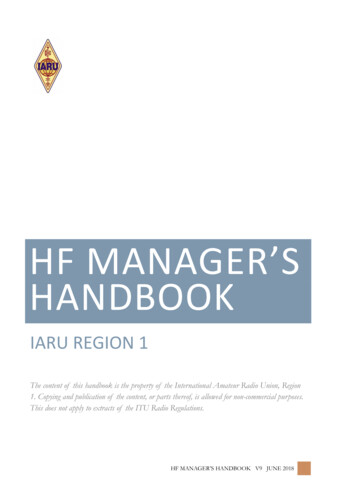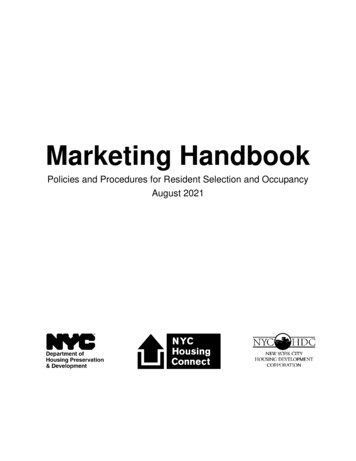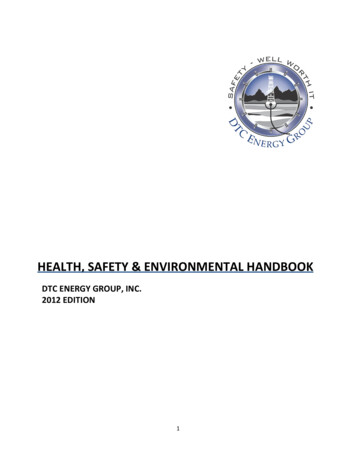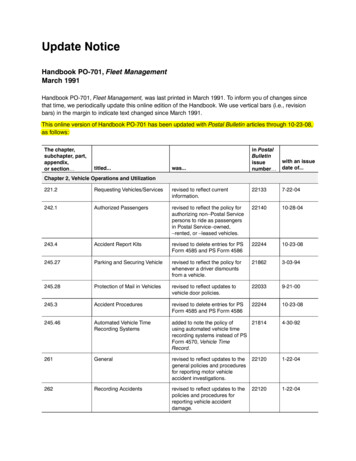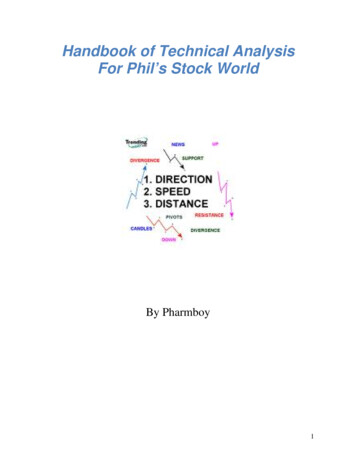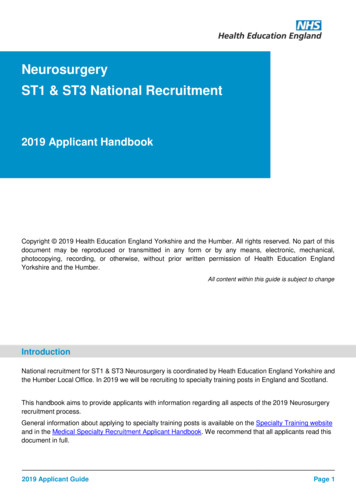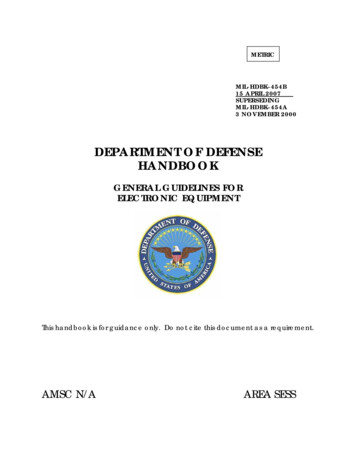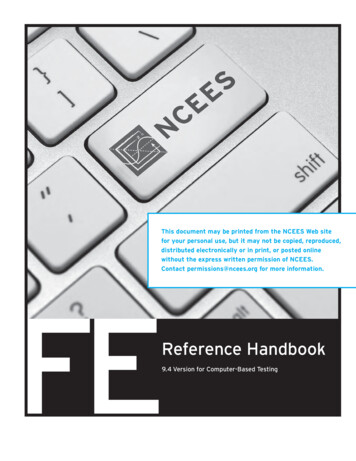
Transcription
HANDBOOK OFBI O L O G I C A LSTATISTICST H I R DE D I T I O NJOHN H. MCDONALDUniversity of DelawareSPARKY HOUSE PUBLISHINGBaltimore, Maryland, U.S.A.
2014 by John H. McDonaldNon-commercial reproduction of this content, with attribution, is permitted;for-profit reproduction without permission is prohibited.See http://www.biostathandbook.com/permissions.html for details.
CONTENTSContentsBasicsIntroduction . 1Step-by-step analysis of biological data . 3Types of biological variables . 6Probability. 14Basic concepts of hypothesis testing . 16Confounding variables . 24Tests for nominal variablesExact test of goodness-of-fit . 29Power analysis . 40Chi-square test of goodness-of-fit . 45G–test of goodness-of-fit . 53Chi-square test of independence . 59G–test of independence . 68Fisher’s exact test of independence . 77Small numbers in chi-square and G–tests . 86Repeated G–tests of goodness-of-fit . 90Cochran–Mantel–Haenszel test for repeated tests of independence . 94Descriptive statisticsStatistics of central tendency . 101Statistics of dispersion. 107Standard error of the mean . 111Confidence limits . 115Tests for one measurement variableStudent’s t–test for one sample . 121Student’s t–test for two samples . 126Independence . 131Normality . 133Homoscedasticity and heteroscedasticity . 137Data transformations. 140One-way anova . 145Kruskal–Wallis test . 157Nested anova . 165Two-way anova. 173Paired t–test . 180Wilcoxon signed-rank test . 186i
on and linear regression. 190Spearman rank correlation . 209Curvilinear regression . 213Analysis of covariance . 220Multiple regression . 229Simple logistic regression . 238Multiple logistic regression . 247Multiple testsMultiple comparisons . 254Meta-analysis . 261MiscellanyUsing spreadsheets for statistics . 266Guide to fairly good graphs . 274Presenting data in tables . 283Getting started with SAS . 285Choosing a statistical test . 293ii
INTRODUCTIONIntroductionWelcome to the Third Edition of the Handbook of Biological Statistics! This textbookevolved from a set of notes for my Biological Data Analysis class at the University ofDelaware. My main goal in that class is to teach biology students how to choose theappropriate statistical test for a particular experiment, then apply that test and interpretthe results. In my class and in this textbook, I spend relatively little time on themathematical basis of the tests; for most biologists, statistics is just a useful tool, like amicroscope, and knowing the detailed mathematical basis of a statistical test is asunimportant to most biologists as knowing which kinds of glass were used to make amicroscope lens. Biologists in very statistics-intensive fields, such as ecology,epidemiology, and systematics, may find this handbook to be a bit superficial for theirneeds, just as a biologist using the latest techniques in 4-D, 3-photon confocal microscopyneeds to know more about their microscope than someone who’s just counting the hairson a fly’s back. But I hope that biologists in many fields will find this to be a usefulintroduction to statistics.I have provided a spreadsheet to perform many of the statistical tests. Each comeswith sample data already entered; just download the spreadsheet, replace the sample datawith your data, and you’ll have your answer. The spreadsheets were written for Excel, butthey should also work using the free program Calc, part of the OpenOffice.org suite ofprograms. If you’re using OpenOffice.org, some of the graphs may need re-formatting,and you may need to re-set the number of decimal places for some numbers. Let me knowif you have a problem using one of the spreadsheets, and I’ll try to fix it.I’ve also linked to a web page for each test wherever possible. I found most of theseweb pages using John Pezzullo’s excellent list of Interactive Statistical Calculation Pages(www.statpages.org), which is a good place to look for information about tests that arenot discussed in this handbook.There are instructions for performing each statistical test in SAS, as well. It’s not aseasy to use as the spreadsheets or web pages, but if you’re going to be doing a lot ofadvanced statistics, you’re going to have to learn SAS or a similar program sooner or later.Printed versionWhile this handbook is primarily designed for online use(www.biostathandbook.com), you can also buy a spiral-bound, printed copy of the wholehandbook for 18 plus shipping biological-statistics/3862228I’ve used this print-on-demand service as a convenience to you, not as a money-makingscheme, so please don’t feel obligated to buy one. You can also download a free pdf of thewhole book from www.biostathandbook.com/HandbookBioStatThird.pdf, in case you’dlike to print it yourself or view it on an e-reader.1
HANDBOOKOFBIOLOGICALSTATISTICSIf you use this handbook and want to cite it in a publication, please cite it as:McDonald, J.H. 2014. Handbook of Biological Statistics, 3rd ed. Sparky House Publishing,Baltimore, Maryland.It’s better to cite the print version, rather than the web pages, so that people of the futurecan see exactly what were citing. If you just cite a web page, it might be quite different bythe time someone looks at it a few years from now. If you need to see what someone hascited from an earlier edition, you can download pdfs of the first st.pdf) or the second ond.pdf).I am constantly trying to improve this textbook. If you find errors, broken links, typos,or have other suggestions for improvement, please e-mail me at mcdonald@udel.edu. Ifyou have statistical questions about your research, I’ll be glad to try to answer them.However, I must warn you that I’m not an expert in all areas of statistics, so if you’reasking about something that goes far beyond what’s in this textbook, I may not be able tohelp you. And please don’t ask me for help with your statistics homework (unless you’rein my class, of course!).AcknowledgmentsPreparation of this handbook has been supported in part by a grant to the Universityof Delaware from the Howard Hughes Medical Institute Undergraduate ScienceEducation Program.Thanks to the students in my Biological Data Analysis class for helping me learn howto explain statistical concepts to biologists; to the many people from around the worldwho have e-mailed me with questions, comments and corrections about the previouseditions of the Handbook; to my patient wife, Beverly Wolpert, for being so patient while Iobsessed over writing this; and to my dad, Howard McDonald, for inspiring me to getaway from the computer and go outside once in a while.2
STEP- ‐BY- ‐STEPANALYSISOFBIOLOGICALDATAStep-by-step analysis ofbiological dataHere I describe how you should determine the best way to analyze your biologicalexperiment.How to determine the appropriate statistical testI find that a systematic, step-by-step approach is the best way to decide how to analyzebiological data. I recommend that you follow these steps:1. Specify the biological question you are asking.2. Put the question in the form of a biological null hypothesis and alternate hypothesis.3. Put the question in the form of a statistical null hypothesis and alternate hypothesis.4. Determine which variables are relevant to the question.5. Determine what kind of variable each one is.6. Design an experiment that controls or randomizes the confounding variables.7. Based on the number of variables, the kinds of variables, the expected fit to theparametric assumptions, and the hypothesis to be tested, choose the best statisticaltest to use.8. If possible, do a power analysis to determine a good sample size for the experiment.9. Do the experiment.10. Examine the data to see if it meets the assumptions of the statistical test you chose(primarily normality and homoscedasticity for tests of measurement variables). If itdoesn’t, choose a more appropriate test.11. Apply the statistical test you chose, and interpret the results.12. Communicate your results effectively, usually with a graph or table.As you work your way through this textbook, you’ll learn about the different parts ofthis process. One important point for you to remember: “do the experiment” is step 9, notstep 1. You should do a lot of thinking, planning, and decision-making before you do anexperiment. If you do this, you’ll have an experiment that is easy to understand, easy toanalyze and interpret, answers the questions you’re trying to answer, and is neither toobig nor too small. If you just slap together an experiment without thinking about howyou’re going to do the statistics, you may end up needing more complicated and obscurestatistical tests, getting results that are difficult to interpret and explain to others, and3
HANDBOOKOFBIOLOGICALSTATISTICSmaybe using too many subjects (thus wasting your resources) or too few subjects (thuswasting the whole experiment).Here’s an example of how the procedure works. Verrelli and Eanes (2001) measuredglycogen content in Drosophila melanogaster individuals. The flies were polymorphic at thegenetic locus that codes for the enzyme phosphoglucomutase (PGM). At site 52 in thePGM protein sequence, flies had either a valine or an alanine. At site 484, they had either avaline or a leucine. All four combinations of amino acids (V-V, V-L, A-V, A-L) werepresent.1. One biological question is “Do the amino acid polymorphisms at the Pgm locus havean effect on glycogen content?” The biological question is usually something aboutbiological processes, often in the form “Does changing X cause a change in Y?”You might want to know whether a drug changes blood pressure; whether soil pHaffects the growth of blueberry bushes; or whether protein Rab10 mediatesmembrane transport to cilia.2. The biological null hypothesis is “Different amino acid sequences do not affect thebiochemical properties of PGM, so glycogen content is not affected by PGMsequence.” The biological alternative hypothesis is “Different amino acidsequences do affect the biochemical properties of PGM, so glycogen content isaffected by PGM sequence.” By thinking about the biological null and alternativehypotheses, you are making sure that your experiment will give different resultsfor different answers to your biological question.3. The statistical null hypothesis is “Flies with different sequences of the PGM enzymehave the same average glycogen content.” The alternate hypothesis is “Flies withdifferent sequences of PGM have different average glycogen contents.” While thebiological null and alternative hypotheses are about biological processes, thestatistical null and alternative hypotheses are all about the numbers; in this case,the glycogen contents are either the same or different. Testing your statistical nullhypothesis is the main subject of this handbook, and it should give you a clearanswer; you will either reject or accept that statistical null. Whether rejecting astatistical null hypothesis is enough evidence to answer your biological questioncan be a more difficult, more subjective decision; there may be other possibleexplanations for your results, and you as an expert in your specialized area ofbiology will have to consider how plausible they are.4. The two relevant variables in the Verrelli and Eanes experiment are glycogencontent and PGM sequence.5. Glycogen content is a measurement variable, something that you record as anumber that could have many possible values. The sequence of PGM that a fly has(V-V, V-L, A-V or A-L) is a nominal variable, something with a small number ofpossible values (four, in this case) that you usually record as a word.6. Other variables that might be important, such as age and where in a vial the flypupated, were either controlled (flies of all the same age were used) or randomized(flies were taken randomly from the vials without regard to where they pupated).It also would have been possible to observe the confounding variables; forexample, Verrelli and Eanes could have used flies of different ages, and then useda statistical technique that adjusted for the age. This would have made the analysismore complicated to perform and more difficult to explain, and while it mighthave turned up something interesting about age and glycogen content, it wouldnot have helped address the main biological question about PGM genotype andglycogen content.7. Because the goal is to compare the means of one measurement variable amonggroups classified by one nominal variable, and there are more than two categories,4
STEP- ‐BY- ‐STEPANALYSISOFBIOLOGICALDATAthe appropriate statistical test is a one-way anova. Once you know what variablesyou’re analyzing and what type they are, the number of possible statistical tests isusually limited to one or two (at least for tests I present in this handbook).8. A power analysis would have required an estimate of the standard deviation ofglycogen content, which probably could have been found in the publishedliterature, and a number for the effect size (the variation in glycogen contentamong genotypes that the experimenters wanted to detect). In this experiment, anydifference in glycogen content among genotypes would be interesting, so theexperimenters just used as many flies as was practical in the time available.9. The experiment was done: glycogen content was measured in flies with differentPGM sequences.10. The anova assumes that the measurement variable, glycogen content, is normal(the distribution fits the bell-shaped normal curve) and homoscedastic (thevariances in glycogen content of the different PGM sequences are equal), andinspecting histograms of the data shows that the data fit these assumptions. If thedata hadn’t met the assumptions of anova, the Kruskal–Wallis test or Welch’s testmight have been better.11. The one-way anova was done, using a spreadsheet, web page, or computerprogram, and the result of the anova is a P value less than 0.05. The interpretationis that flies with some PGM sequences have different average glycogen contentthan flies with other sequences of PGM.12. The results could be summarized in a table, but a more effective way tocommunicate them is with a graph:Glycogen content in Drosophila melanogaster. Each bar represents the mean glycogen content (inmicrograms per fly) of 12 flies with the indicated PGM haplotype. Narrow bars represent 95%confidence intervals.ReferenceVerrelli, B.C., and W.F. Eanes. 2001. The functional impact of PGM amino acidpolymorphism on glycogen content in Drosophila melanogaster. Genetics 159: 201-210.(Note that for the purposes of this web page, I’ve used a different statistical test thanVerrelli and Eanes did. They were interested in interactions among the individualamino acid polymorphisms, so they used a two-way anova.)5
HANDBOOKOFBIOLOGICALSTATISTICSTypes of biological variablesThere are three main types of variables: measurement variables, which are expressedas numbers (such as 3.7 mm); nominal variables, which are expressed as names (such as“female”); and ranked variables, which are expressed as positions (such as “third”). Youneed to identify the types of variables in an experiment in order to choose the correctmethod of analysis.IntroductionOne of the first steps in deciding which statistical test to use is determining what kindsof variables you have. When you know what the relevant variables are, what kind ofvariables they are, and what your null and alternative hypotheses are, it’s usually prettyeasy to figure out which test you should use. I classify variables into three types:measurement variables, nominal variables, and ranked variables. You’ll see other namesfor these variable types and other ways of classifying variables in other statisticsreferences, so try not to get confused.You’ll analyze similar experiments, with similar null and alternative hypotheses,completely differently depending on which of these three variable types are involved. Forexample, let’s say you’ve measured variable X in a sample of 56 male and 67 femaleisopods (Armadillidium vulgare, commonly known as pillbugs or roly-polies), and your nullhypothesis is “Male and female A. vulgare have the same values of variable X.” If variableX is width of the head in millimeters, it’s a measurement variable, and you’d comparehead width in males and females with a two-sample t–test or a one-way analysis ofvariance (anova). If variable X is a genotype (such as AA, Aa, or aa), it’s a nominal variable,and you’d compare the genotype frequencies in males and females with a Fisher’s exacttest. If you shake the isopods until they roll up into little balls, then record which is thefirst isopod to unroll, the second to unroll, etc., it’s a ranked variable and you’d compareunrolling time in males and females with a Kruskal–Wallis test.Measurement variablesMeasurement variables are, as the name implies, things you can measure. Anindividual observation of a measurement variable is always a number. Examples includelength, weight, pH, and bone density. Other names for them include “numeric” or“quantitative” variables.Some authors divide measurement variables into two types. One type is continuousvariables, such as length of an isopod’s antenna, which in theory have an infinite numberof possible values. The other is discrete (or meristic) variables, which only have wholenumber values; these are things you count, such as the number of spines on an isopod’santenna. The mathematical theories underlying statistical tests involving measurementvariables assume that the variables are continuous. Luckily, these statistical tests workwell on discrete measurement variables, so you usually don’t need to worry about the6
TYPESOFBIOLOGICALVARIABLESdifference between continuous and discrete measurement variables. The only exceptionwould be if you have a very small number of possible values of a discrete variable, inwhich case you might want to treat it as a nominal variable instead.When you have a measurement variable with a small number of values, it may not beclear whether it should be considered a measurement or a nominal variable. For example,let’s say your isopods have 20 to 55 spines on their left antenna, and you want to knowwhether the average number of spines on the left antenna is different between males andfemales. You should consider spine number to be a measurement variable and analyzethe data using a two-sample t–test or a one-way anova. If there are only two differentspine numbers—some isopods have 32 spines, and some have 33—you should treat spinenumber as a nominal variable, with the values “32” and “33,” and compare theproportions of isopods with 32 or 33 spines in males and females using a Fisher’s exacttest of independence (or chi-square or G–test of independence, if your sample size is reallybig). The same is true for laboratory experiments; if you give your isopods food with 15different mannose concentrations and then measure their growth rate, mannoseconcentration would be a measurement variable; if you give some isopods food with 5mM mannose, and the rest of the isopods get 25 mM mannose, then mannoseconcentration would be a nominal variable.But what if you design an experiment with three concentrations of mannose, or five, orseven? There is no rigid rule, and how you treat the variable will depend in part on yournull and alternative hypotheses. If your alternative hypothesis is “different values ofmannose have different rates of isopod growth,” you could treat mannose concentrationas a nominal variable. Even if there’s some weird pattern of high growth on zero mannose,low growth on small amounts, high growth on intermediate amounts, and low growth onhigh amounts of mannose, a one-way anova could give a significant result. If youralternative hypothesis is “isopods grow faster with more mannose,” it would be better totreat mannose concentration as a measurement variable, so you can do a regression. In myclass, we use the following rule of thumb:—a measurement variable with only two values should be treated as a nominalvariable;—a measurement variable with six or more values should be treated as a measurementvariable;—a measurement variable with three, four or five values does not exist.Of course, in the real world there are experiments with three, four or five values of ameasurement variable. Simulation studies show that analyzing such dependent variableswith the methods used for measurement variables works well (Fagerland et al. 2011). I amnot aware of any research on the effect of treating independent variables with smallnumbers of values as measurement or nominal. Your decision about how to treat yourvariable will depend in part on your biological question. You may be able to avoid theambiguity when you design the experiment—if you want to know whether a dependentvariable is related to an independent variable that could be measurement, it’s a good ideato have at least six values of the independent variable.Something that could be measured is a measurement variable, even when you set thevalues. For example, if you grow isopods with one batch of food containing 10 mMmannose, another batch of food with 20 mM mannose, another batch with 30 mMmannose, etc. up to 100 mM mannose, the different mannose concentrations are ameasurement variable, even though you made the food and set the mannoseconcentration yourself.Be careful when you count something, as it is sometimes a nominal variable andsometimes a measurement variable. For example, the number of bacteria colonies on aplate is a measurement variable; you count the number of colonies, and there are 87colonies on one plate, 92 on another plate, etc. Each plate would have one data point, thenumber of colonies; that’s a number, so it’s a measurement variable. However, if the plate7
HANDBOOKOFBIOLOGICALSTATISTICShas red and white bacteria colonies and you count the number of each, it is a nominalvariable. Now, each colony is a separate data point with one of two values of the variable,“red” or “white”; because that’s a word, not a number, it’s a nominal variable. In this case,you might summarize the nominal data with a number (the percentage of colonies that arered), but the underlying data are still nominal.RatiosSometimes you can simplify your statistical analysis by taking the ratio of twomeasurement variables. For example, if you want to know whether male isopods havebigger heads, relative to body size, than female isopods, you could take the ratio of headwidth to body length for each isopod, and compare the mean ratios of males and femalesusing a two-sample t–test. However, this assumes that the ratio is the same for differentbody sizes. We know that’s not true for humans—the head size/body size ratio in babiesis freakishly large, compared to adults—so you should look at the regression of headwidth on body length and make sure the regression line goes pretty close to the origin, asa straight regression line through the origin means the ratios stay the same for differentvalues of the X variable. If the regression line doesn’t go near the origin, it would be betterto keep the two variables separate instead of calculating a ratio, and compare theregression line of head width on body length in males to that in females using an analysisof covariance.Circular variablesOne special kind of measurement variable is a circular variable. These have theproperty that the highest value and the lowest value are right next to each other; often, thezero point is completely arbitrary. The most common circular variables in biology are timeof day, time of year, and compass direction. If you measure time of year in days, Day 1could be January 1, or the spring equinox, or your birthday; whichever day you pick, Day1 is adjacent to Day 2 on one side and Day 365 on the other.If you are only considering part of the circle, a circular variable becomes a regularmeasurement variable. For example, if you’re doing a polynomial regression of bearattacks vs. time of the year in Yellowstone National Park, you could treat “month” as ameasurement variable, with March as 1 and November as 9; you wouldn’t have to worrythat February (month 12) is next to March, because bears are hibernating in Decemberthrough February, and you would ignore those three months.However, if your variable really is circular, there are special, very obscure statisticaltests designed just for circular data; chapters 26 and 27 in Zar (1999) are a good place tostart.Nominal variablesNominal variables classify observations into discrete categories. Examples of nominalvariables include sex (the possible values are male or female), genotype (values are AA,Aa, or aa), or ankle condition (values are normal, sprained, torn ligament, or broken). Agood rule of thumb is that an individual observation of a nominal variable can beexpressed as a word, not a number. If you have just two values of what would normallybe a measurement variable, it’s nominal instead: think of it as “present” vs. “absent” or“low” vs. “high.” Nominal variables are often used to divide individuals up intocategories, so that other variables may be compared among the categories. In thecomparison of head width in male vs. female isopods, the isopods are classified by sex, anominal variable, and the measurement variable head width is compared between thesexes.8
TYPESOFBIOLOGICALVARIABLESNominal v
biological data. I recommend that you follow these steps: 1. Specify the biological question you are asking. 2. Put the question in the form of a biological null hypothesis and alternate hypothesis. 3. Put the question in the form of a statistical null hypothesis and alternate hypothe

